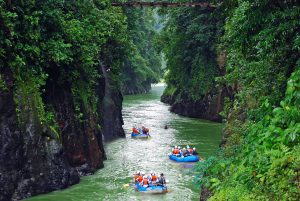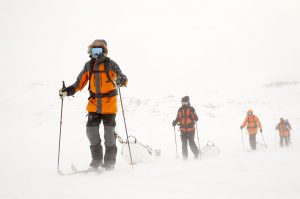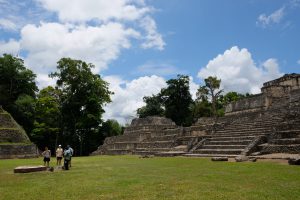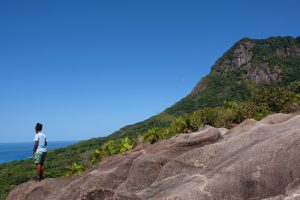
The soaring canyons and sagebrush plains of northern New Mexico have attracted artists, spiritual seekers and free thinkers for over a century. A road trip through the high desert — encountering a hippy commune, artists’ studios, futuristic eco-homes and a Benedictine monastery — uncovers the weird, wild and wonderful soul of the American Southwest
View online at nationalgeographic.com
It’s possible to go years — or a whole lifetime — without considering our infinitesimal place in the vastness of creation. But in the desert of New Mexico, existential revelations seem to come thick and fast. It’s dusk in the Chama River Canyon. I’ve padded uphill from my guest quarters, through a meditation garden decorated with the Stations of the Cross, to join my hosts in their chapel. Soft light streams in through the patchwork of windowpanes, entombing a gory carving of Christ in a grid of radiance and shade. Black-robed Benedictine monks — some wizened, some fresh-faced, many occupying the years in between — chant psalms from the shadowy transepts. “The Lord is my shepherd; I shall not want.” One monk wafts a thurible around the central altar, taking steady steps. “He maketh me to lie down in green pastures; he leadeth me beside the still waters.” Finials of sweet-scented smoke wind languorously through the beams of light.
Outside the tall windows, a sliver of a moon rises over the canyon in a wan, cornflower-blue sky — the last vestiges of a blistering summer’s day. The colours of the landscape slowly intensify, emphasising russet veins in the rock-face — sediment laid down by a powerful river millennia ago. “Even though I walk through the valley of the shadow of death, I will fear no evil,” the monks sing. I’ve now completely lost my place in the hymn book. All I can think about is the improbability of my being here.
I don’t just mean this in the metaphysical sense. Staying at the Monastery of Christ in the Desert, the most remote in the Western Hemisphere, is one of the more outlandish travel experiences of my life. It’s a hard journey to reach the monks — their off-grid home sits at the end of a 13-mile red dirt track outside the pit-stop town of Abiquiu, which is a two-hour drive from the state capital, Santa Fe. Despite my firm agnosticism, I’ve come to sample the solitude and beauty of the monastery; the monks welcome people of all faiths and no faith. I’m invited to dine with them, to labour in the gardens alongside them during the morning work period, and to attend — if I wish — their nine daily church services. The welcome literature also encourages me to join them in a commitment to contemplative silence.
The local crickets, however, have agreed to no such terms; as I return down the hill to bed, their deafening chorus adds texture to the still, black night and, later, seeps into my dreams.
When the steady clang of a bell rings out for 4am vigils and I shuffle blearily back towards the chapel, the darkness of the valley has deepened. Overhead, the entire cosmos is lit up: layer upon layer of distant galaxies and burning suns — a ceiling that puts the Sistine Chapel’s to shame. I reach the steps but, instead of slipping into a pew, I sit outside to watch the stars. Yellow candlelight glows through the cracks in the door behind me; the monks’ ethereal Gregorian chanting spills out into the empty canyon. It feels divine.
“They say the deeper you go into the desert, the more you’ll be sought out. There’s a lure, a fascination,” Abbot Christian tells me on the morning of my departure. It’s the first and only conversation of my stay; one I requested in low whispers from the monk on hospitality duty. The abbot, who joins me on a garden bench, surprises me by being both charming and gregarious — not at all severe or solemn, as I’d imagined. He repeatedly steers the conversation towards ’80s movies and The Beatles; I repeatedly steer it back to the desert. “It’s a strong tradition in monasticism, of course,” he says. “The earliest monks went out into the Egyptian desert. For the solitude, the quiet, the beauty.” Abbot Christian pauses and looks out over the flowerbeds and modest graveyard to the amphitheatre of grasslands and rock spires beyond. “This was created over aeons of time,” he says pensively, echoing my own thoughts. “Man can hardly fathom it.”
The Benedictines aren’t the only ones to find inspiration and solace in this ancient landscape. When I arrive at my rustic cottage at Ghost Ranch, the legendary retreat and education centre an hour’s drive east of the monastery, the smattering of people I encounter around the main compound seems to have been plucked from a circus. A bare-chested man juggles beanbags; a troupe of blindfolded women are attempting to circle a cottonwood tree; and tiny children dressed in tie-dye rough-and-tumble on the scrubby lawn. “We attract a lot of artists. A lot of solo travellers too. Most people are on their own private journeys,” Karen Butts, the tours and education manager, explains. “This remote corner has always attracted interesting characters.”
One of the best known of these characters was 20th-century American painter Georgia O’Keeffe, who fled the patriarchal confines of New York in the ’40s and made this 21,000-acre estate her home and her muse. Perdenal, a narrow mesa nine miles to the south, was her favourite subject. “It’s my private mountain. God told me if I painted it enough I could have it,” O’Keeffe once joked. As with the monks, people made long pilgrimages to seek out O’Keeffe in the desert; guests at her humble cottage included artists Frida Kahlo and Andy Warhol, and the psychiatrist Carl Jung.
I head out to explore more of the ranch on horseback, a set of watercolour paints tucked into my saddlebag in case inspiration strikes. Three tough-as-nails Texan cowgirls run the ranch stables (one vice-like handshake cracks all my knuckles), and they lead our small party with the flair and swagger of rodeo pros. It’s wild, wild country. Red dust streams from our horses’ hooves as we navigate dried riverbeds, passing trees mangled by lightning; I feel like we’ve left the planet, not just the homestead. Threatening clouds roll in, darkening the land. Around us, large ravens croak murderously.
Our guides lean into the atmosphere, telling spooky tales of slaughtered cattle poachers and buried treasure, and the legend of Vivaron, a giant mythical rattlesnake that was said to curl around the base of nearby Orphan Mesa. The tour segues into palaeontology (some of the most significant Triassic dinosaur finds continue to be made beneath the ground here), touches on movies (it was a location in Indiana Jones And The Kingdom Of The Crystal Skull, as well as a number of Westerns) and concludes with some showstopping geology. “See those two mesas in the distance,” Rachel says as we dismount to rest our horses. “Five million years ago, they made up the sides of a super volcano, maybe 20,000ft high, until it exploded with the force of three nuclear bombs.” It’s a chilling metric to choose, an allusion to the state’s role in the birth of the atomic age: the first ever A-bomb was developed in nearby Los Alamos and detonated in an area south of here. It’s a reminder that the desert doesn’t only bring out the best in mankind.
A sudden clap of thunder makes the horses buck and whinny, and a burst of rain soaks us all to the skin, releasing the rich scents of juniper bushes, minerally dust and the horses’ sweat. On the canyon walls, pastel yellows and mauves transform into the colour of angry bruises. But then, as quickly as it started, the storm abates; the clouds part and the light returns.
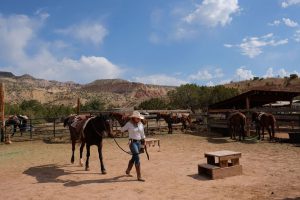
Ghost Ranch is a legendary retreat and education centre an hour’s drive east of the Monastery of Christ in the Desert. Credit: Amelia Duggan
Out of this world
In northern New Mexico, all roads lead to Santa Fe. It’s always been that way. Since its founding as a Spanish colony in 1610, the city has been a crossroads for major trade routes — it was one of the northern termini of the Camino Real de Tierra Adentro from Mexico City and the start of the Santa Fe Trail, a wagon route that stretched across the Great Plains to Missouri. The result, perhaps unsurprisingly, is that the city — the second oldest in the US — is a melting pot of cultures, producing food, architecture and art unlike that found anywhere else in the country. It’s the latter that Santa Fe particularly prides itself on; it’s said there’s a greater concentration of artists here than in any other US city. I lose count of the number of galleries and museums I pass as I wander through the Canyon Road arts district, ending up in the heart of the low-rise, adobe-style historic centre.
On first impression, Santa Fe strikes me as unnervingly polished: the leafy streets, with their uniform heritage aesthetic and eye-wateringly expensive boutiques, jar with the authenticity and rawness of life in the desert. But it doesn’t take long to get a taste for it. At one corner of the main plaza, a fajita cart wafts tempting scents my way; on the other side, under the rickety eaves of the Palace of the Governors, Native American artists from some of the state’s 23 tribes are exhibiting shimmery micaceous clay pottery and handcrafted turquoise jewellery. Down at the market in the Railyard district, I pick up punnets of plump rainier cherries, chilli jam and bundles of dried sage, and after encouragement from the proprietor, John, buy a pair of vintage cowboy boots from the legendary Kowboyz shop. In the crisp heat of midday, I eat and shop and eat some more until it’s time to hail a taxi to the city’s newest — and weirdest — attraction.
Across town in a disused bowling alley donated by local arts patron and Game of Thrones creator George R R Martin, a renegade collective of artists called Meow Wolf has built an art experience that simulates the concept of the multiverse. I’m ushered into a full-size family home with one instruction: to riffle through the house to find clues as to what befell its inhabitants. It’s not a mystery that’s easily solved. The house, I discover, is riddled with wormholes. In the kitchen, I open the fridge and discover a white tunnel that twists into a ‘frozen’ lair. Lost somewhere else in the house’s trippy hinterland, I gleefully bash out a tune on the xylophone rib cage of a dinosaur skeleton; and some hours later, I end up navigating a maze of aerial gangways and treehouses in a glowing, mutated garden. Whatever happened here is clearly out of this world. I wonder if House of Eternal Return could’ve been dreamed up anywhere other than New Mexico — a state renowned for alleged extra-terrestrial sightings and the covert government ops of Roswell and Area 51, where nature itself often seems to flaunt the limits of possibility.
Each sunset here is a unique masterpiece, I find; a free light show that pulls new colours from the world like a magician drawing handkerchiefs from a hat. All one has to do is get in place. That evening, I head to the bell tower bar at the La Fonda on the Plaza, a century-old hotel that stands on the site of the city’s very first inn. These days, it’s decked out with a $2m art collection. I wince my way through a super-strength margarita and watch the sky blush pink then deep red as the plump, tangerine orb of the sun drops behind the shadowy Sangre de Cristo Mountains.
Taking the high road
I drive towards these peaks the next day, taking a slow, scenic route known as the High Road, en route to the Taos art colony. Were I to live in these parts, it’s the sort of road trip I imagine I’d take just for the hell of it on lazy Sundays: the tarmac bends and soars through piñon pine forests and villages overlooking badlands pierced by rock spires.
Settlements along the High Road wear their Spanish heritage proudly, and none more so than Chimayó. Here, at Trujillo’s Weaving Shop, I get chatting to the owner, Carlos. “My family has been in this business for eight generations; we trace our ancestry in the Chimayó Valley to settlers in the 1700s. Times are changing; I don’t know if the next generation will want to weave, like I did,” he tells me, pausing work at a large wooden loom. Geometric tapestries and rugs hang on the walls; many patterns date back to the first Spanish communities to settle here, often reflecting Navajo influences. “Some are very complicated,” Carlos says, stroking one of his creations. “I try to make one a year, to preserve the style — to preserve the tradition.”
Down the road is another Carlos: an artist, and grower of heirloom Chimayó chillies. His open studio, Medina’s Gallery, is stuffed with Catholic tchotchkes, paintings and bags of ground chilli. He breaks open a pistachio nut and uses a half shell to scoop up a fiery powder for me to try. “You’re tasting the past,” he says, “Little has changed in the way this is made in centuries. We honour our roots.” Across the road is the adobe chapel his grandfather built to Santo Niño de Atocha. It sits next door to the more famous Santuario de Chimayó, a church with a pit of ‘healing dirt’ — the focus of a vast pilgrimage each Holy Week. “Forty thousand people!,” Carlos exclaims, throwing his hands up. But it’s his family’s little, less-visited chapel that truly captures my imagination. Shelves, pews and even the rafters are filled with children’s shoes — petitions to this manifestation of Christ as a child, who’s thought to be in constant need of new footwear because he tirelessly wanders the Earth looking for people to help. It’s a haunting sight, looking like a ramshackle nursery with no wards.
For my last days in northern New Mexico, I’m staying in a vintage Airstream trailer in the barren sagebrush plains outside of Taos town centre. It’s another taste of desert life: in the mornings, I drink stove-brewed coffee on my wooden deck, stoke the embers of my fire pit, and watch the sun spill over the spine of Taos Mountain.
The area is fascinating, a mecca for the stridently individual and left-field communities that seem to flourish in this desert. Just to the north west, across the dramatic Rio Grande Gorge, lies a village of around 70 Earthships — gorgeous, Gaudíesque eco-homes built from upcycled materials like glass bottles that flash like exotic insects in the midday sun.
To the east is Taos Pueblo, the only living Native American community designated as both a UNESCO World Heritage Site and a National Historic Landmark. The multistorey adobe structure at its heart, on the banks of Red Willow Creek, dates back a thousand years. Unlike in other parts of the country, the people of Taos Pueblo weren’t forced onto reserves, and in 1970 they even won back 48,000 acres of their ancestral territory from the government.
And further north, on a remote hillside carpeted with ponderosa pine, is the region’s last surviving hippy commune from the 1960s. “We don’t really say ‘commune’ anymore; Lama Foundation is a conscious community,” Kestrel Alexander, a resident of four years, advises me. “We’re committed to inter-spirituality, as opposed to an ashram where there’s one teacher, one philosophy. And there’s no alcohol and no drugs here; I think that’s why Lama survived so long and ultimately the others didn’t.”
I’m at the retreat to take part in a contact improvisation workshop, which turns out to be an hour of free movement involving leaning upon one another and entangling limbs in a slow, ecstatic dance. It’s perhaps the least British thing I’ve ever done, and one of the most liberating. Afterwards, we hike to a lookout point and watch misty rain showers roll across the plains. I ask Kestrel what draws people here. “I think they’re looking for something that’s missing,” he replies quietly.
Everyone I meet waxes lyrical about this land — the way it gifts you back a part of yourself you thought was lost, or gives you space to worship or create. I’m struck by the spirited individualism of the people here, and the different ways of life kindled into being across the high desert. As many communities across the US become increasingly homogenous, it seems that New Mexicans steadfastly insist on standing out.
Rich Nichols, a local artist I’m introduced to on an evening artisans tour, insists that it’s here, around Taos, that the magic is at its strongest. “Back in Chicago, where I grew up, it was cold, it was industrial. Out here I get to use a whole other side of my palette. For artists, Taos is your mecca, your basilica, a sanctuary, all your chakras aligned, all your ley lines converged. I can’t explain it; you have to try it to know it’s real.”
We’re in his studio surrounded by a forest of easels that prop up his students’ work: luminous, vibrant depictions of flowering deserts, the ancient adobe village of Taos Pueblo, and wild horses with billowing manes. “There’s a saying in Taos: ‘the mountain will either love you, caress you and hold you — or it’ll spit you out’,” he says.
Outside, the sun is setting; another fiery ode to the boldness of life in the high desert. I’m anxious to go and soak it up, to watch the landscape bloom and darken one last time before I head home. It seems to me that life’s secrets might be written across New Mexico’s canyons, if I only knew how to read them. Rich tilts his head to look at me and smiles broadly, as if gifted a vision. “I see it’s embraced you.”
ESSENTIALS
Getting there & around
American Airlines flies from Heathrow to Santa Fe via Dallas; United Airlines flies via Denver.
Average flight time: 15hrs.
When to go
New Mexico gets sunshine year-round. Average temperatures range from 6C in January to 30C in July. July-August often sees rain, so dirt roads like the one to Christ in the Desert can be challenging.
Places mentioned
Monastery of Christ in the Desert
Ghost Ranch
Santa Fe Farmers’ Market
Meow Wolf
Earthship Biotecture
Taos Pueblo
Lama Foundation
Where to stay
La Fonda on the Plaza, Santa Fe
El Farolito, Santa Fe
Casa Gallina, Taos
Hotel Luna Mystica, Taos
The Blake, Taos Ski Valley
More information
taos.org
visitsantafe.com
visittheusa.co.uk
How to do it
Heritage Inspirations offers bespoke guided tours of northern New Mexico, including cultural and artisan tours of Santa Fe, Chimayó, Taos and Taos Pueblo, excursions around Rio Grande Gorge and Ghost Ranch, and glamping retreats in the Chaco Canyon and Taos region. A four-day tour starts from $1,200 (£918) per person (with a group minimum of two people), including transport and some meals but not flights.
Published in the April 2020 issue of National Geographic Traveller (UK)





